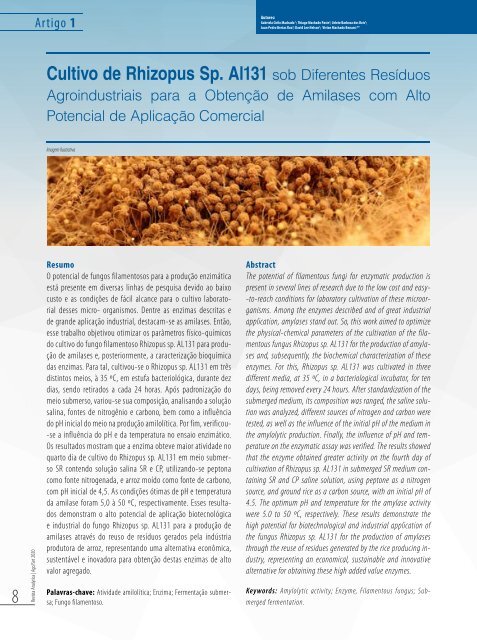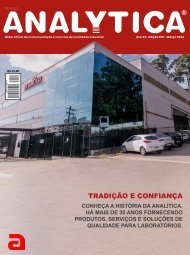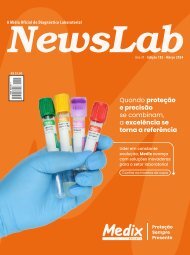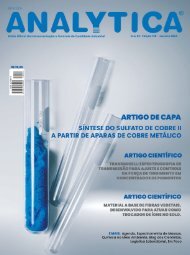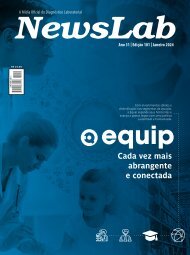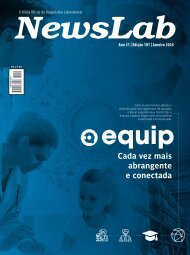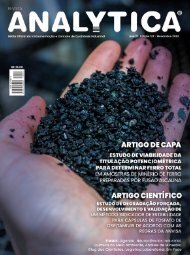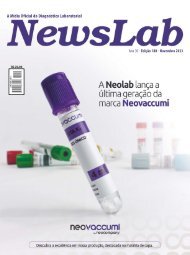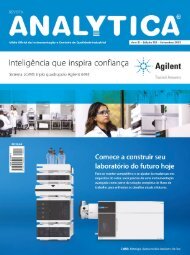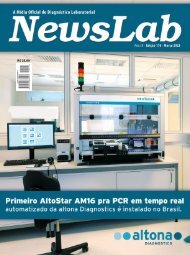Revista Analytica Edição 108
Revista Analytica Edição 108 - Agosto / Setembro 2020
Revista Analytica Edição 108 - Agosto / Setembro 2020
Create successful ePaper yourself
Turn your PDF publications into a flip-book with our unique Google optimized e-Paper software.
Artigo 1<br />
Autores:<br />
Gabriela Cirilo Machado 1 ; Thiago Machado Pasin 2 ; Arlete Barbosa dos Reis 3 ;<br />
Juan Pedro Bretas Roa 4 ; David Lee Nelson 5 ; Vivian Machado Benassi 6 *<br />
Cultivo de Rhizopus Sp. Al131 sob Diferentes Resíduos<br />
Agroindustriais para a Obtenção de Amilases com Alto<br />
Potencial de Aplicação Comercial<br />
Imagem Ilustrativa<br />
8<br />
<strong>Revista</strong> <strong>Analytica</strong> | Ago/Set 2020<br />
Resumo<br />
O potencial de fungos filamentosos para a produção enzimática<br />
está presente em diversas linhas de pesquisa devido ao baixo<br />
custo e as condições de fácil alcance para o cultivo laboratorial<br />
desses micro- organismos. Dentre as enzimas descritas e<br />
de grande aplicação industrial, destacam-se as amilases. Então,<br />
esse trabalho objetivou otimizar os parâmetros físico-químicos<br />
do cultivo do fungo filamentoso Rhizopus sp. AL131 para produção<br />
de amilases e, posteriormente, a caracterização bioquímica<br />
das enzimas. Para tal, cultivou-se o Rhizopus sp. AL131 em três<br />
distintos meios, à 35 ºC, em estufa bacteriológica, durante dez<br />
dias, sendo retirados a cada 24 horas. Após padronização do<br />
meio submerso, variou-se sua composição, analisando a solução<br />
salina, fontes de nitrogênio e carbono, bem como a influência<br />
do pH inicial do meio na produção amilolítica. Por fim, verificou-<br />
-se a influência do pH e da temperatura no ensaio enzimático.<br />
Os resultados mostram que a enzima obteve maior atividade no<br />
quarto dia de cultivo do Rhizopus sp. AL131 em meio submerso<br />
SR contendo solução salina SR e CP, utilizando-se peptona<br />
como fonte nitrogenada, e arroz moído como fonte de carbono,<br />
com pH inicial de 4,5. As condições ótimas de pH e temperatura<br />
da amilase foram 5,0 à 50 ºC, respectivamente. Esses resultados<br />
demonstram o alto potencial de aplicação biotecnológica<br />
e industrial do fungo Rhizopus sp. AL131 para a produção de<br />
amilases através do reuso de resíduos gerados pela indústria<br />
produtora de arroz, representando uma alternativa econômica,<br />
sustentável e inovadora para obtenção destas enzimas de alto<br />
valor agregado.<br />
Palavras-chave: Atividade amilolítica; Enzima; Fermentação submersa;<br />
Fungo filamentoso.<br />
Abstract<br />
The potential of filamentous fungi for enzymatic production is<br />
present in several lines of research due to the low cost and easy-<br />
-to-reach conditions for laboratory cultivation of these microorganisms.<br />
Among the enzymes described and of great industrial<br />
application, amylases stand out. So, this work aimed to optimize<br />
the physical-chemical parameters of the cultivation of the filamentous<br />
fungus Rhizopus sp. AL131 for the production of amylases<br />
and, subsequently, the biochemical characterization of these<br />
enzymes. For this, Rhizopus sp. AL131 was cultivated in three<br />
different media, at 35 ºC, in a bacteriological incubator, for ten<br />
days, being removed every 24 hours. After standardization of the<br />
submerged medium, its composition was ranged, the saline solution<br />
was analyzed, different sources of nitrogen and carbon were<br />
tested, as well as the influence of the initial pH of the medium in<br />
the amylolytic production. Finally, the influence of pH and temperature<br />
on the enzymatic assay was verified. The results showed<br />
that the enzyme obtained greater activity on the fourth day of<br />
cultivation of Rhizopus sp. AL131 in submerged SR medium containing<br />
SR and CP saline solution, using peptone as a nitrogen<br />
source, and ground rice as a carbon source, with an initial pH of<br />
4.5. The optimum pH and temperature for the amylase activity<br />
were 5.0 to 50 ºC, respectively. These results demonstrate the<br />
high potential for biotechnological and industrial application of<br />
the fungus Rhizopus sp. AL131 for the production of amylases<br />
through the reuse of residues generated by the rice producing industry,<br />
representing an economical, sustainable and innovative<br />
alternative for obtaining these high added value enzymes.<br />
Keywords: Amylolytic activity; Enzyme, Filamentous fungus; Submerged<br />
fermentation.


